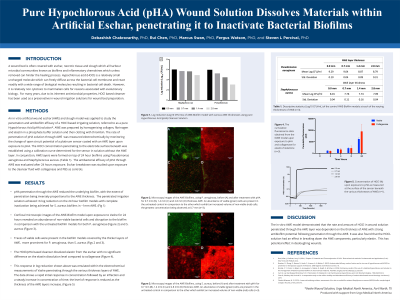Laboratory Research
(LR-006) Hypochlorous Acid Wound Solution Dissolves Materials within artificial eschar, penetrating it to Inactivate Bacterial Biofilms

A wound bed is often covered with eschar, necrotic tissue and slough which all harbour microbial communities known as biofilms and inflammatory chemokines which unless removed can hinder the healing process. Hypochlorous acid (HOCl) is a relatively small uncharged molecule which can freely diffuse across the bacterial cell membrane and react readily with a wide range of biological molecules resulting in bacterial cell death. However, it is relatively non cytotoxic to mammalian cells for reasons associated with evolutionary biology. For many years, due to its inherent antimicrobial properties, HOCl has been used as a preservative in wound irrigation solutions for wound bed preparation.
Methods:
An in vitro artificial wound eschar (AWE) and slough model was applied to study the penetration and antibiofilm efficacy of a HOCl irrigating solution*. AWE was prepared by homogenising collagen, fibrinogen and elastin in a phosphate buffer solution and then clotting with thrombin. The rate of penetration of HOCl solution through AWE was measured electrochemically by monitoring the change of open circuit potential of a platinum sensor coated with an AWE layer upon exposure to HOCl. The HOCl concentration penetrating to the electrode surface beneath was established using a calibration curve determined for the sensor in solution without the AWE layer. In conjunction, AWE layers were formed on top of 24 hour biofilms using Pseudomonas aeruginosa and Staphylococcus aureus. The antibacterial efficacy of HOCl through AWE was evaluated after 24 hours exposure. Eschar breakdown was studied upon exposure to the cleanser fluid.
Results:
The penetration of HOCl through the AWE layer was monitored in real time and seen to penetrate fastest with higher concentrations of HOCl for thin AWE layers (~1mm) with the inverse being true for thicker layers (~2mm). The penetrated irrigation solution achieved >6 log reduction on the 24 hour biofilm models with complete inactivation being achieved for S. aureus biofilms in ~1mm AWE. The HOCl based cleanser dissolved elastin from the eschar.
Discussion:
The in vitro AWE model demonstrated that the rate and amount of HOCl in wound solution penetrated through the AWE layer was dependent on the thickness of AWE with strong antibiofilm potential following penetration through the AWE. It was also found that the HOCL solution had an effect in breaking down the AWE components, particularly elastin. This has potential effect in desloughing wounds.
Trademarked Items: Vashe Wound Solution
References: 1. Murphy C, Atkin L, Swanson T, et al. Defying hard-to-heal wounds with an early antibiofilm intervention strategy: wound hygiene. J Wound Care. 2020 Mar 1;29(Sup3b):S1-S26
2. Armstrong DG, Bohn G, Glat P, Kavros SJ, Kirsner R, Snyder R, Tettelbach W.Armstrong DG, et al. Expert Recommendations for the Use of Hypochlorous Solution: Science and Clinical Application. Ostomy Wound Management 2015 May;61(5): S2-S19.
3. Block, Michael S, and Brian G Rowan. “Hypochlorous Acid: A Review.” Journal of oral and maxillofacial surgery: official journal of the American Association of Oral and Maxillofacial Surgeons vol. 78,9 (2020): 1461-1466.
4. Dissemond J. Wound cleansing: benefits of hypochlorous acid. Journal of Wound Care Published Online:5 Oct 2020
5. Gold MH, Andriessen A, Bhatia AC, Bitter P Jr, Chilukuri S, Cohen JL, Robb CW. Topical stabilized hypochlorous acid: The future gold standard for wound care and scar management in dermatologic and plastic surgery procedures. J Cosmet Dermatol. 2020 Feb;19(2):270-277.
6. Sakarya S, Gunay N, Karakulak M, Ozturk B, Ertugrul B. Hypochlorous acid: an ideal wound care agent with powerful microbicidal, antibiofilm, and wound healing potency. Wounds 2014;26(12):342–350.
7. Robson MC, Payne WG, et al. Hypochlorous Acid as a Potential Wound Care Agent: Part II. Stabilized Hypochlorous Acid: Its Role in Decreasing Tissue Bacterial Bioburden and Overcoming the Inhibition of Infection on Wound Healing. J Burns Wounds. 2007 Apr 11;6:e6.
8. Hiebert JM, Robson MC. The Immediate and Delayed Post-Debridement Effects on Tissue Bacterial Wound Counts of Hypochlorous Acid Versus Saline Irrigation in Chronic Wounds. Eplasty. 2016;16: e32. Published 2016 Dec 1.
9. Niezgoda J, Sordi P, Hermans M. Evaluation of Vashe wound therapy in the clinical management of patients with chronic wounds. Adv Skin Wound Care 2010;23(8):352-357
10. Oropallo AR, Andersen C et al. Guidelines for Point-of-Care Fluorescence Imaging for Detection of Wound Bacterial Burden Based on Delphi Consensus. Diagnostics (Basel). 2021 Jul 6;11(7):1219

.png)
